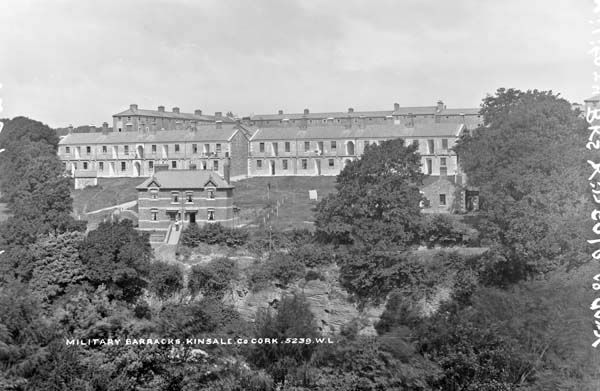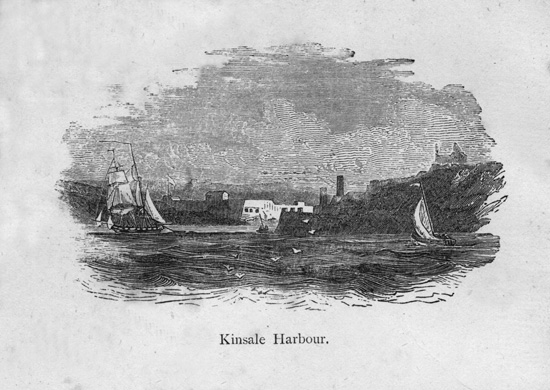
On the afternoon of 12 July, fighting, window breaking and shouting disturbed the residents of Kinsale, a small Cork town with a large barracks on the outskirts. A group of Antrim militiamen who had been drinking in a local pub began to break windows and overturn milk churns, ignoring the remonstrances of the town’s Anglican clergyman. 1 A Catholic priest of ‘delicate’ health was beaten. 2 According to local witnesses, the men used ‘party’ expressions, which indicated their support for the Orange Order’s celebration of 12 July. Other militiamen, who were not part of the violent group, were attacked by townspeople who turned on anyone wearing the Antrim militia uniform. Pickets were sent out to restore order, but discipline broke down when these men encountered their beaten comrades and skirmishes between military and civilians continued. The police tried to intervene but were forced to withdraw in the face of well-armed military opposition. 3 Order was finally restored when a party of Royal Artillery from Charles Fort, 3 km away from the town, arrived to forcibly escort the militia back to barracks. The next day, soldiers from the Scots Greys and the Royal Horse Artillery arrived from Cork city to keep order.
This riot was instantly a ‘party’ matter, in which religious denomination and political sympathies determined responses. Two inquiries – one civil, one military – were held to determine the cause of the violence and it’s extent. These open public inquiries were extensively documented in Cork newspapers and received particular attention in Belfast, an area in the militia’s recruiting district. At the investigation’s conclusion, the nationalist Cork Examiner was certain that ‘the whole affair was an Orange display’. 4 The Southern Reporter, ‘a whig-radical journal’ 5 ignored the causative factors of Orangeism while concluding that both sides were at fault. It did remind readers that the militiamen were more seriously injured than the townspeople, indicating some sympathy for the military side. 6 In Belfast, the Daily Mercury, which was read by ‘conservatively minded Protestant Liberals’, 7 believed that the riot was ‘entirely caused by the brutal and savage conduct of the townspeople’. The editorial writer explained that ‘low population of the South – bloated with ignorance and superstition – regard Protestant Ulster with a deadly hatred – a hatred all the more intense because it is based on fear’. 8 Although initially critical of the Antrim militia, the evidence convinced the Unionist Belfast Newsletter that these were not ‘Orange Riots’. 9 The violence was ‘of Romish origin’ and was ‘premeditated by the townspeople who took part in them’. 10 Another Belfast paper, the Morning Post chose to reproduce the Southern Reporter editorial, which ignored Orangeism altogether. 11 The Irishman, a resolutely Catholic and fervently nationalist publication, did not wait for the public inquiry and immediately decried ‘Military Ruffianism at Kinsale’. 12 Unsurprisingly, violence on 12 July between Antrim Protestants and Southern Catholics divided newspaper editors.
The incident gave rise to a ballad, which was helpfully preserved in the press when the inquiry refused to accept it as evidence. 13 Ballads were often composed to mark local scandals, but only a fraction of these have survived. I have reproduced it in full below, even though the tune remains a mystery. This song was heard on the streets of Kinsale in the days following the riot, in spite of an order to suppress it. 14
A NEW SONG CALLED “THE BATTLE OF KINSALE ; OR THE DEFEAT OF THE ANTRIM ORANGEMEN”
July the 12th in Kinsale town we had a famous battle,
When Orangemen we made lie down when at us they did rattle,
Papist blood they said they would spill, and each man drew his bayonet,
But a brave small band of Kinsale men those Orange dogs defeated.
From their barracks they did march, Papist for to slaughter,
In memory of that glorious day that Billy crossed the water;
We boldly met them in the streets, and gave them no quarter,
And they will remember Kinsale town now and ever after.
Those Orangemen were very brave at breaking door by dozens;
Smashing windows in the streets, kicking milk pails and churns;
With Orange lilies in their breasts, the sergeants were the leaders;
Oh, they’re poor props to King and Crown, the Belfast filthy weavers.
Those Orangemen were four to one, and thought they would be victorious;
But we very soon made them give way and made them fly before us.
Thirty-five we did put down, the rest from the streets we hunted,
And eight of them will soon see h-ll for they are mortally wounded.
They thought our chapel to break down, but we had them well guarded,
And these Antrim Orange dogs had not the pluck to dare it;
For we were reinforced by peasantry, and we soon became well armed
With guns and pikes, and swords and scythes, and a line of battle formed.
Then we marched through Kinsale town to see if they would oppose us;
But the Orange had very well known that we would mow them down before us,
And when they go to the Black North, themselves can tell the story,
How the Os and the Macs, the sturdy whacks, pulled down their Orange glory.
You Orangemen of this green isle, come now lay down your arms,
And no more insult the Os and Macs, for they will give you no quarters;
Priest hunting days are all gone by, when you pulled down our altars,
And King Billy down to h-ll is gone where you all will go hereafter.
(Cork Examiner, 27 July 1859.)
So what started the riot? Was it sectarian? The civil inquiry concluded it was all about a girl, Mary Connor, who was the first person called to give evidence. 15 She stated that on 10 July her brother was about to beat her for being out late when a number of militiamen intervened to stop him. 16 A fight started, and two soldiers were badly injured. The bad feeling that arose from this incident was the root cause of the riot, according to the civil investigation. This wasn’t the only example of conflict between the Antrims and townspeople. In June, a local woman had been assaulted and warned against keeping company with Orangemen. 17 On 9 July, a ‘simple man’ – a man with intellectual disabilities – complained to the police that militiamen asked if he was a Roman Catholic and assaulted him when he replied in the affirmative. 18
Conflict between civilians and military men was relatively common in garrison towns, but the political dimension of these assaults bothered authorities. On hearing rumours of a planned Orange demonstration, the magistrates and police called the militia’s officers to a meeting. The officers argued that no compelling reason existed to confine the men to barracks on 12 July. 19 Sub-Inspector Richard Hadnett was not convinced: on 11 July, he brought 10 additional policemen into Kinsale. 20 With their preparations made, the police could only wait and watch. When a party of drunken Antrims issued from a pub on the afternoon of 12 July, Hadnett must have feared the worst. A toxic mix of personal animosity, alcohol and ‘party’ spirit caused a serious riot that led to the Antrim militia being removed to England to complete its service.

- Kinsale riot reports (House of Commons, 1860), p 8. Full text here: http://www.dippam.ac.uk/eppi/documents/14185. ↩
- A Rev. Carton, whose evidence appears in Kinsale riot reports, p 10. ↩
- Kinsale riot reports, p 14. ↩
- Cork Examiner, 29 July 1859 ↩
- John Windele, Historical and Descriptive Notices of the City of Cork, (1840) p 140. ↩
- Southern Reporter 27 July 1859. ↩
- http://www.victorianperiodicals.com/series3/single_sample.asp?id=109692 ↩
- Belfast Daily Mercury, 29 July 1859 ↩
- Belfast Newsletter, 25 July 1859. ↩
- Belfast Newsletter, 30 July 1859. ↩
- Belfast Morning Post, 29 July 1859. ↩
- Irishman, 16 July 1859. ↩
- C.P. Wallis, solicitor for the Antrim militia, argued that the song was evidence of local provocation Cork Examiner, 27 July 1859. ↩
- Cork Examiner, 27 July 1859. ↩
- Kinsale riot reports, p 5. ↩
- Kinsale riot reports, p 5; On p 12, RIC Head Constable Gale claimed that her brother admitted to hitting her. ↩
- Kinsale riot reports, p 13. ↩
- Kinsale riot reports, p 11. ↩
- Kinsale riot reports, p 13. ↩
- Kinsale riot reports, p 14. ↩